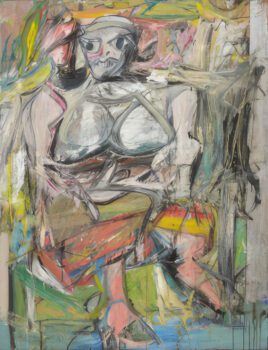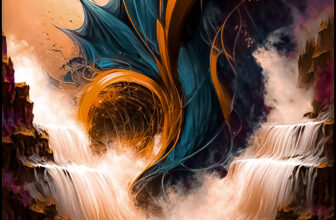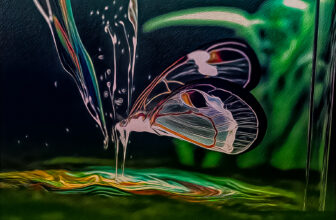Meaning of Woman I by Willem de Kooning
In the realm of postwar art, few paintings have stirred as much intrigue, admiration, and controversy as Woman I by Willem de Kooning. Created between 1950 and 1952, this masterpiece is not just a painting, it is a powerful confrontation between form and chaos, tradition and rebellion, beauty and grotesquery. It speaks to the era it was born into while transcending it, engaging viewers in a raw, visceral encounter with the image of womanhood and the very process of painting itself.
This is the story of Woman I, how it was painted, what it means, and why it still grips audiences over 70 years later.
Who Was Willem de Kooning?
To understand Woman I, we must begin with the man behind the brush. Willem de Kooning was a Dutch-American painter born in Rotterdam in 1904. He immigrated to the United States in 1926 as a stowaway, eventually settling in New York City. There, de Kooning became one of the central figures of Abstract Expressionism, a postwar art movement that emphasized emotional intensity, spontaneity, and large-scale non-representational works.
Yet unlike his peers Jackson Pollock or Mark Rothko, who abandoned figuration entirely, de Kooning never fully let go of the human form. This tension, between abstraction and figuration, would define much of his career and explode most forcefully in Woman I.
De Kooning was fascinated with the female form. “Flesh was the reason oil painting was invented,” he famously declared. But his representations of women weren’t straightforward. They weren’t romanticized Madonnas or sleek nudes. They were primal, chaotic, confrontational. And none more so than Woman I.
Woman I, A Battle on Canvas
De Kooning began Woman I in 1950 and worked on it obsessively for two years. He painted and repainted it, scraping away layers of paint, reapplying them, revising the figure again and again. He was known to destroy entire passages of the painting in frustration. This grueling process can still be seen in the final piece; it’s a palimpsest of struggle and persistence.
Standing over 6 feet tall and nearly 4 feet wide, Woman I is painted in oil on canvas. It features a large, ferociously rendered female figure with wide eyes, a toothy grin, massive breasts, and flailing limbs. The background is abstract and chaotic, an energetic swirl of greens, grays, and whites. The figure seems to simultaneously emerge from and dissolve into the canvas.
De Kooning reportedly painted at a frenetic pace, often using brushes, rags, knives, whatever was at hand. He described the process as a kind of wrestling match. It was not just about depicting a woman, it was about expressing a feral, complex vision of femininity through violent, unrelenting mark-making.
What Is Happening in Woman I?
At first glance, the painting can be jarring, even disturbing. The figure in Woman I is not passive, gentle, or eroticized in the traditional Western canon of female portraiture. She is exaggerated, monstrous, overpowering. Her wide, toothy grin borders on the menacing. Her eyes seem to follow you, not with warmth, but with wild intensity. She is both seated and not seated, with her body and surroundings morphing into each other through vigorous brushstrokes.
There is a sense of motion, as if the woman is caught mid-expression, or mid-transformation. Her massive, pendulous breasts dominate the composition, a deliberate emphasis that evokes fertility symbols, prehistoric goddesses, and perhaps even the mass-media pin-up girls of the 1950s. Yet this is no idealized figure. She is raw, untamed, a force of nature.
The scene is not narrative in a traditional sense. There’s no story or setting. But what is happening is the act of painting itself: a psychological drama between the artist and the subject, played out through line, color, and texture.
What Does Woman I Represent?
Woman I is not just a portrait. It is a confrontation. At its core, the painting grapples with the image of womanhood in modern culture. It collapses multiple representations into one explosive figure, ancient fertility icons, modern pin-ups, religious Madonnas, classical nudes, even magazine advertisements.
In the early 1950s, America was experiencing a postwar return to domestic ideals. Mass media heavily promoted images of the perfect housewife, while Cold War ideologies reinforced gender roles. De Kooning’s Woman I can be seen as both a reflection and a rejection of these ideals. His woman is not passive. She resists containment. She is many things at once: seductive, violent, maternal, grotesque, mythic.
Some feminist critics have challenged the work for its seemingly aggressive portrayal of women, interpreting it as misogynistic. Others have defended it as a radical deconstruction of the female stereotype, a psychological self-examination, or even a love-hate letter to femininity. De Kooning himself remained cryptic. “I’m not sure,” he said. “I was painting the woman in me.”
Symbolism and Layers of Meaning
The symbolic power of Woman I lies in its contradictions. She is both an idol and a monster. She evokes ancient female figures like the Venus of Willendorf or mother goddesses, yet she is also a product of modern visual culture. The smile may echo the seductive grin of a 1950s advertisement model, while the toothiness and bulging eyes undermine that glamour with an undercurrent of menace.
Her exaggerated body parts, particularly the breasts, are symbolic of fertility and sexuality but are rendered in such a way that they become absurd or grotesque. This ambiguity unsettles viewers, forcing them to confront their own assumptions about gender, beauty, and desire.
Some scholars view the painting as a metaphor for artistic creation itself. The figure of Woman becomes a kind of muse, simultaneously inspiring and tormenting the male artist. The act of repeatedly painting, destroying, and repainting her reflects the struggles inherent in the creative process.
There is also an element of existential crisis. Created in the shadow of World War II and during the rise of the nuclear age, Woman I channels a kind of post-apocalyptic energy. The figure seems both prehistoric and futuristic, timeless and deeply rooted in the psychological tensions of its moment.
What Type of Art is Woman I?
Woman I is a cornerstone of Abstract Expressionism, but it’s also a radical outlier. While many of De Kooning’s contemporaries pursued pure abstraction, eschewing any recognizable subject matter, De Kooning merged abstraction with figuration in a way that broke all the rules.
In particular, the painting is an example of gestural abstraction, also known as action painting. This style is characterized by dynamic brushwork, physical engagement with the canvas, and emphasis on the process of creation. The emphasis is not on finishing a polished product, but on expressing raw emotion through the physical act of painting.
What makes Woman I unique is how it marries this gestural abstraction with the human figure. The woman is recognizable, but just barely. She’s caught in the flux between appearing and disappearing, between form and formlessness.
This tension places the work in a category of its own, somewhere between traditional portraiture and radical expressionist deconstruction. It challenges the very definition of what painting is, and what a “portrait” can mean.
Where Is Woman I Located Painting Today?
Woman I is part of the permanent collection of The Museum of Modern Art (MoMA) in New York City. It was acquired in 1953, soon after its completion, and remains one of the museum’s most iconic works. Visitors can find it hanging in MoMA’s galleries of Abstract Expressionism, alongside other giants of the era such as Pollock, Rothko, and Newman.
It remains a centerpiece in discussions of mid-century art, not only because of its notoriety but also because it opened the floodgates for a whole series of Woman paintings that de Kooning would produce in the following years.
The impact of Woman I cannot be overstated. When it debuted, it scandalized many. Critics were divided. Some called it violent, vulgar, even anti-feminine. Others praised its audacity and raw vitality. Clement Greenberg, the influential art critic, initially opposed it but later acknowledged its power.
Over time, the painting has come to be seen not as an insult to femininity, but as a complex exploration of it. It disrupted conventional notions of beauty and paved the way for future artists, both male and female, to challenge the norms of representation.
De Kooning’s willingness to engage with figuration in an abstract idiom opened doors for later movements like Neo-Expressionism. Artists such as Cecily Brown, Jenny Saville, and even Francis Bacon have cited him as an influence. His chaotic, intuitive brushwork and psychological intensity continue to inspire artists and viewers alike.
The Woman Who Won’t Sit Still
Woman I is more than just paint on canvas. It is a reckoning, a vortex of art history, psychology, and cultural critique. It resists simple categorization. It dares to ask hard questions about gender, art, and identity. It is, in a sense, an anti-icon: a monument not to idealization but to tension, ambiguity, and the complexity of being.
In creating Woman I, Willem de Kooning did not give us a definitive image of a woman. Instead, he gave us a battlefield, a space where beauty and brutality collide, where tradition is torn apart and reassembled into something utterly new.
In that act, he did not just paint a woman. He painted a revolution.




